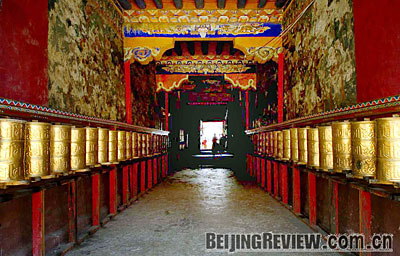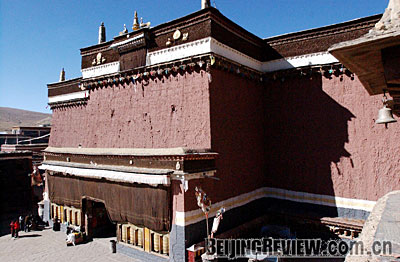|
 |
|
FORMER GLORY: The passage to the main hall of Sakya Monastery glows after its ongoing refurbishment (XINHUA) |
It has taken seven years to rebuild the pride of Tibetan Buddhism. With its northern section reduced to rubble during the purging of the "cultural revolution" (1966-76), Sakya Monastery, once the historical, cultural and political center of Tibet, will be restored to its former glory by September 2009.
The restoration is part of a multimillion-dollar commitment from the Chinese Government that began in 2002. The launch of the "Three Cultural Relic" repair campaign at that time saw 380 million yuan ($56 million) pumped into conserving and maintaining the three major cultural relics in Tibet--the Potala Palace, Norbulingka Park and Sakya Monastery. About 100 million yuan ($14.6 million) alone has been invested in preserving Sakya. The name means gray soil in Tibetan after the color of the surrounding earth. Its walls were painted with resplendent red, white and gray murals.
The monastery is a "must see" site for travelers to Tibet. Not only does it house the largest number of Tibetan Buddhist sutras in China, but it was also the seat of power in 13th century Tibet.
In the 13th century when the Yuan Dynasty (1279-1368) exercised its sovereignty over Tibet, a number of master craftsmen were dispatched from the interior to work on the building, resulting in the monastery's eclectic combination of Tibetan, Mongolian and Han architectural styles.
Miracle survivor
Sakya was originally made up of a southern and northern monastery, but today the name applies mainly to the southern section covering 14,000 square meters. The Northern Monastery, built in 1073 and eight times bigger than its neighbor, was torn down during the "cultural revolution."
 |
|
SACRED TEXT REPOSITORY: Sakya Monastery in Tibet houses vast volumes of Tibetan Buddhist sutras. Repair work will be completed in September this year (XINHUA) |
During the decade-long "cultural revolution," over 80 percent of China's historical reserves, artifacts and sites of interest suffered devastating and often permanent damage as they were thought to be at the root of "old ways of thinking."
It was a miracle that the Southern Monastery survived. Nyima Tsering, a senior official in charge of the "Three Cultural Relic" repair work, told Beijing Review that there were two reasons it was ignored. "After the Northern Monastery was pulled down, the then officials decided to keep the Southern Monastery as evidence of negative teaching material for the coming generations, so that they could get a glimpse at how extravagant and wasteful the monastery once was," he said.
| 